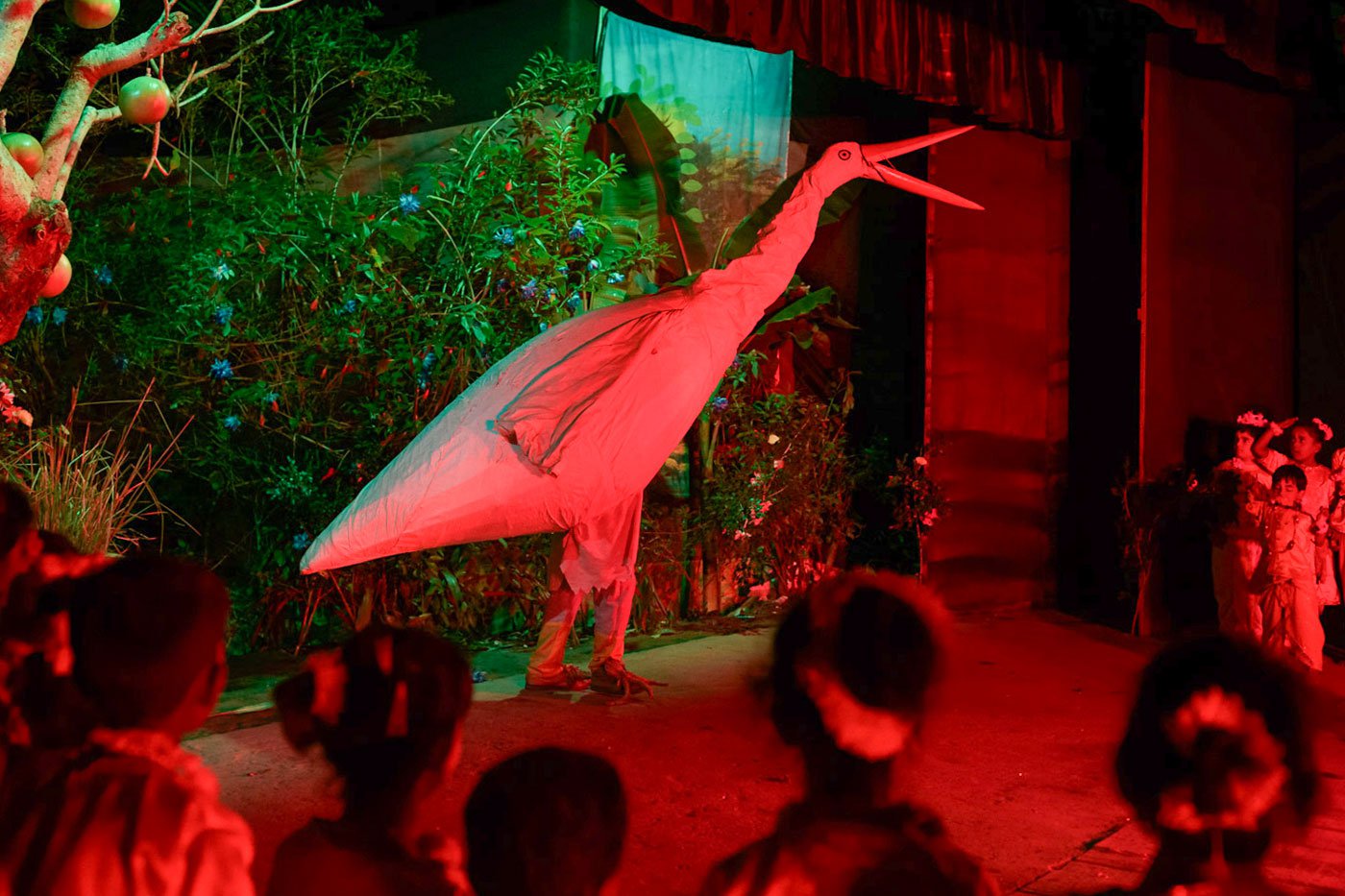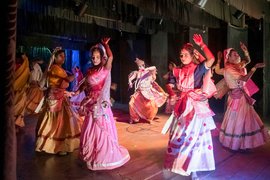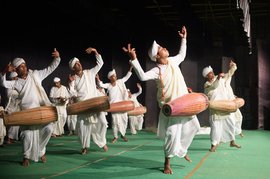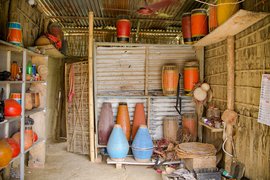“I loved drawing since I was a child. When I was in ko shreni [Class 1] in school, the teacher would ask us to draw an orange or a pumpkin, and I could do it quickly,” says Ramesh Dutta with a smile briefly playing on his face. “That is how it all began.”
Today he is the primary set designer and mask maker for theatre activities in Majuli’s Garamur Saru Satra – one of Assam’s several Vaishnavite monasteries. Ramesh da , as the 52-year-old is fondly addressed in the community, is a man of few words but many talents that keep local theatre, art and music thriving in Majuli, the largest island in the Brahmaputra.
“As a child I was fascinated by puppetry shows,” he recalls. “I used to watch other people make puppets and picked up the art that way. I must have been in Class 2 around that time. I would make puppets and show them off in school.”
The art he makes these days, when not displayed on stage or around Majuli, is stored in the open shed beside his house. When we visit him we also see an inverted hand boat inside, propped on a platform. Brushes and cans of paint are stored next to masks made by Ramesh da . These include a movable mask of a crane made for the Raas Mahotsav. (Read: The many masks of Majuli )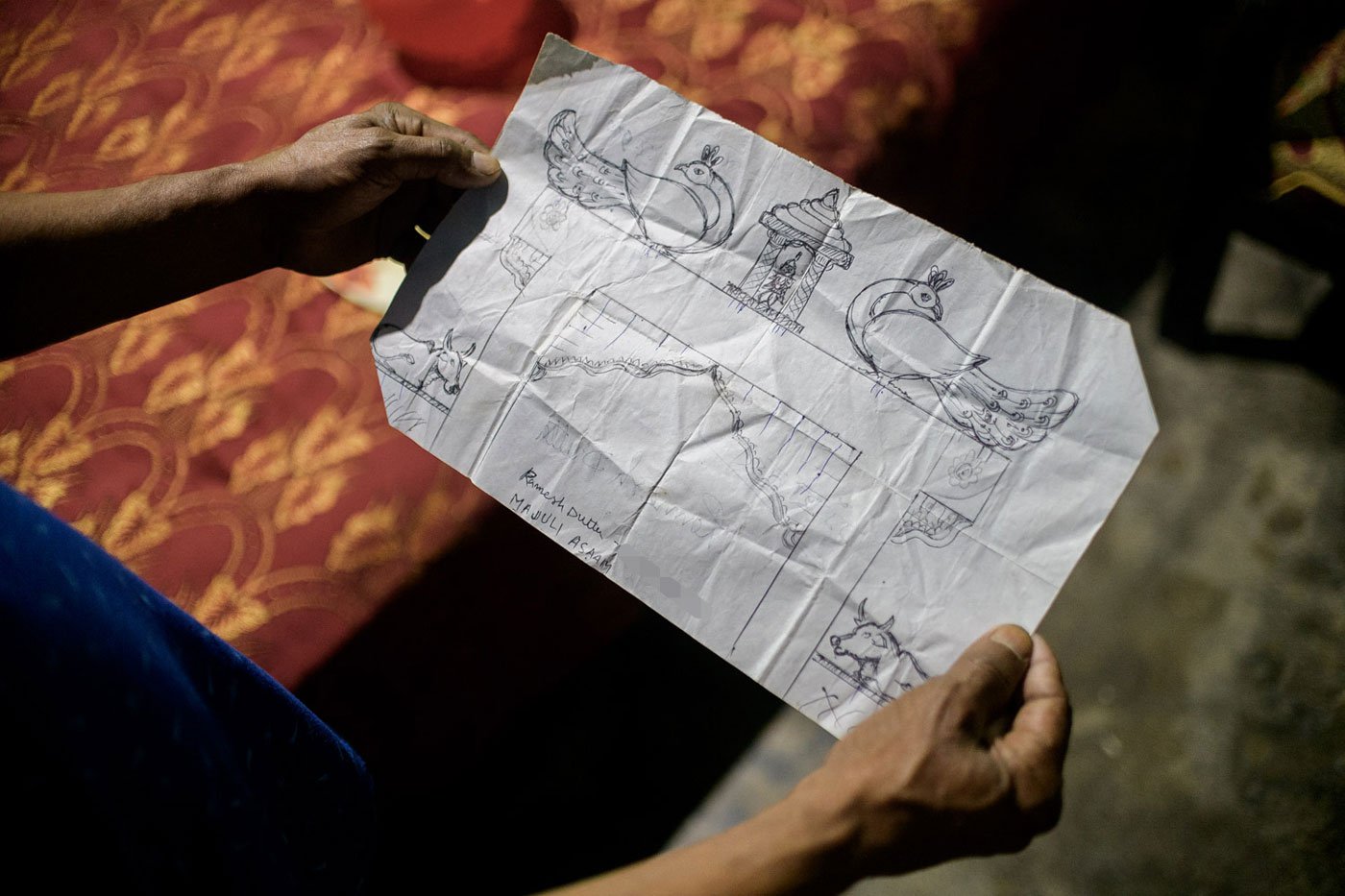
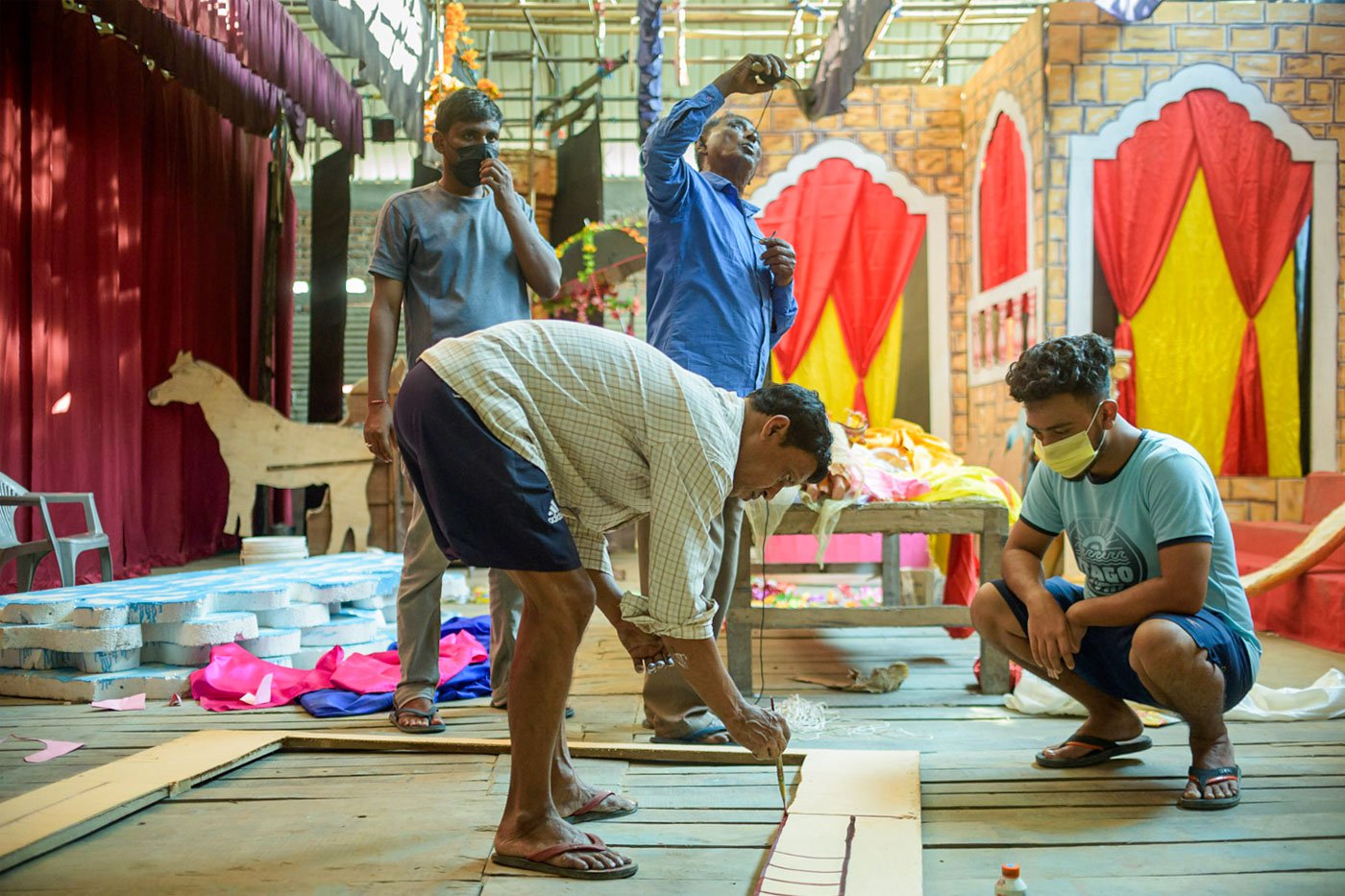
Ramesh Dutta (left) shows a hand-drawn set design for the Raas Mahotsav. In the auditorium of the Garamur Saru Satra, he gets the set ready for the 2022 Raas performances
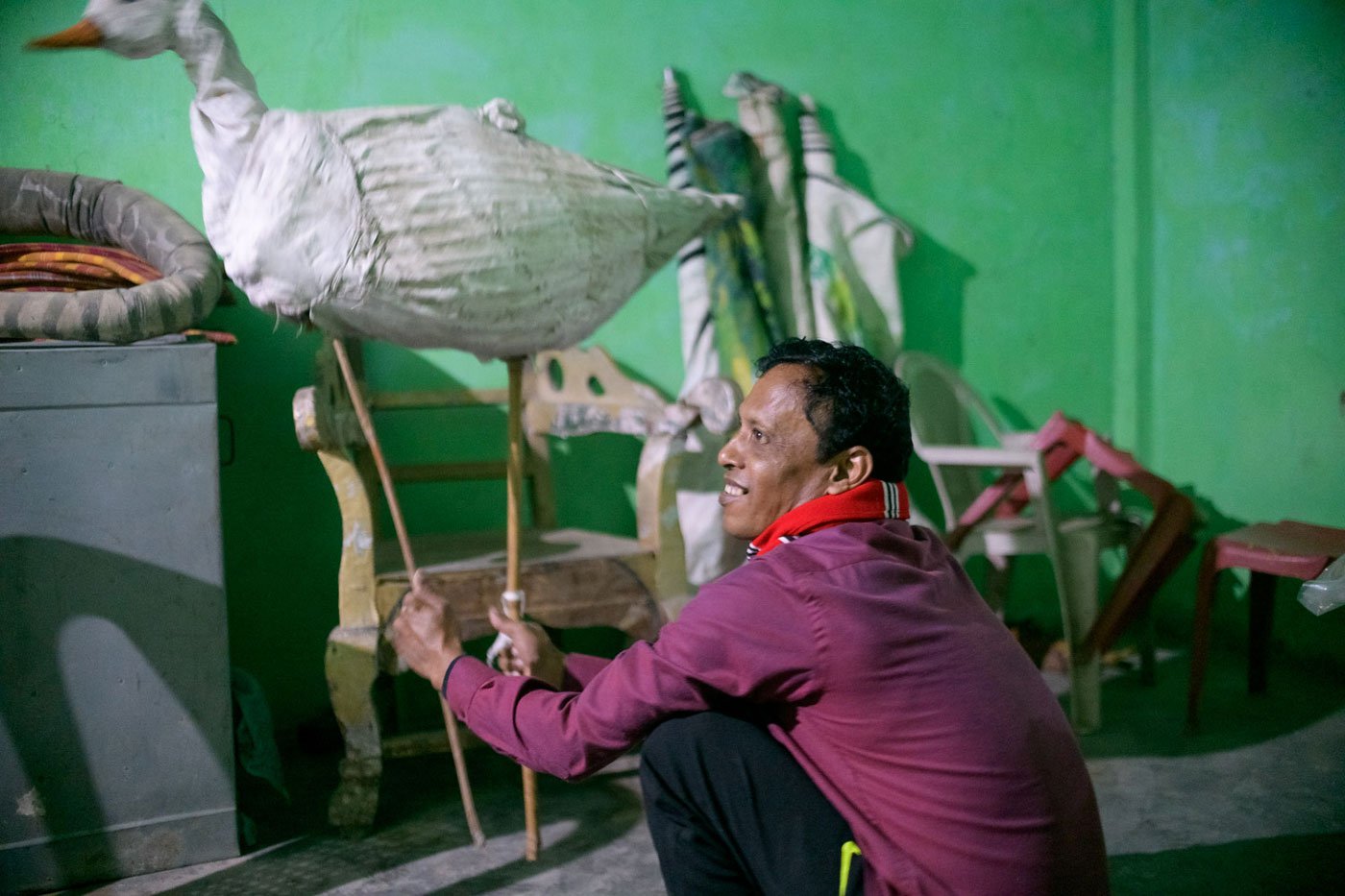
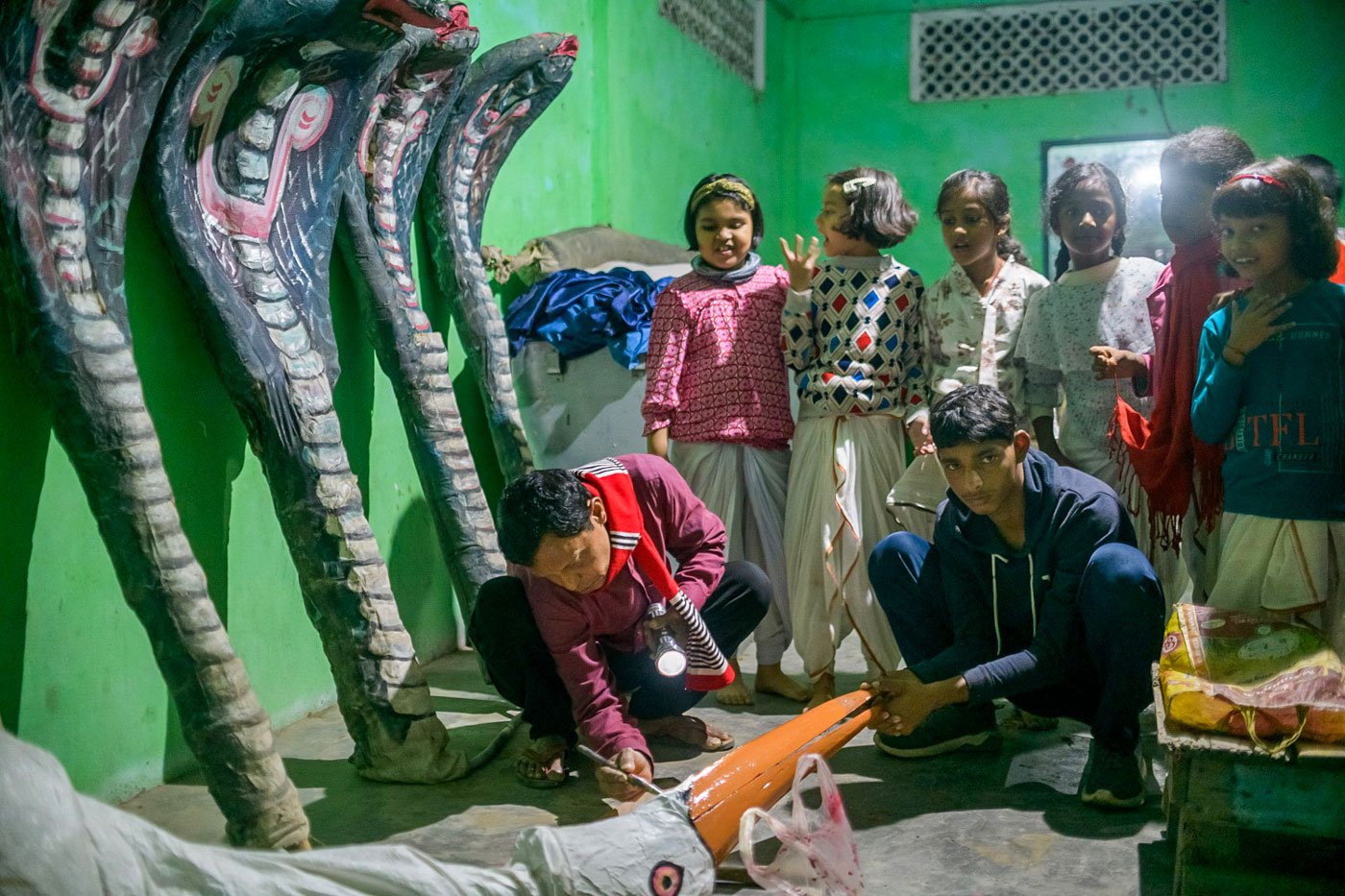
Left: The artist demonstrates how to animate a sculpture using a pair of sticks. Right: Curious children look on as he applies finishing touches to a crane costume to be used during Raas
Although today he does not make many masks, Ramesh da admires the artform and those who practise it like Padma Shri awardee Hem Chandra Goswami. “His masks can blink and move their lips,” he says. “He has made the art of masks world famous and popular. He has so many students now.”
During the Raas festival, Dutta undertakes repair work for masks in addition to working on the set design and stage props for the performances in the Garamur Saru Satra. He confidently declares, “If tomorrow were Raas, I could make the sets today itself.” (Read: Raas Mahotsav and the satras of Majuli )
Dutta also takes part in the various Vaishnav sattriya performances conducted at the satra , such as Gayan-Bayan and Bhaonas. The former is a folk performance made of singers ( gayan ) and instrument players ( bayan ) whereas the latter is a form of drama. Integral parts of sattriya culture, the performances were introduced by social reformer and saint Srimanta Sankaradeva in the 15th century. The gayans and bayans have the responsibility of providing musical accompaniment to the performances held in the satra .
“I started learning gayan-bayan in 1984 at the Pitambar Dev Sanskritik Vidyalaya. I was 13 at the time,” he tells us. “I initially learned both gayan and bayan but then the guru asked me to be a gayan . So, that’s what I studied.”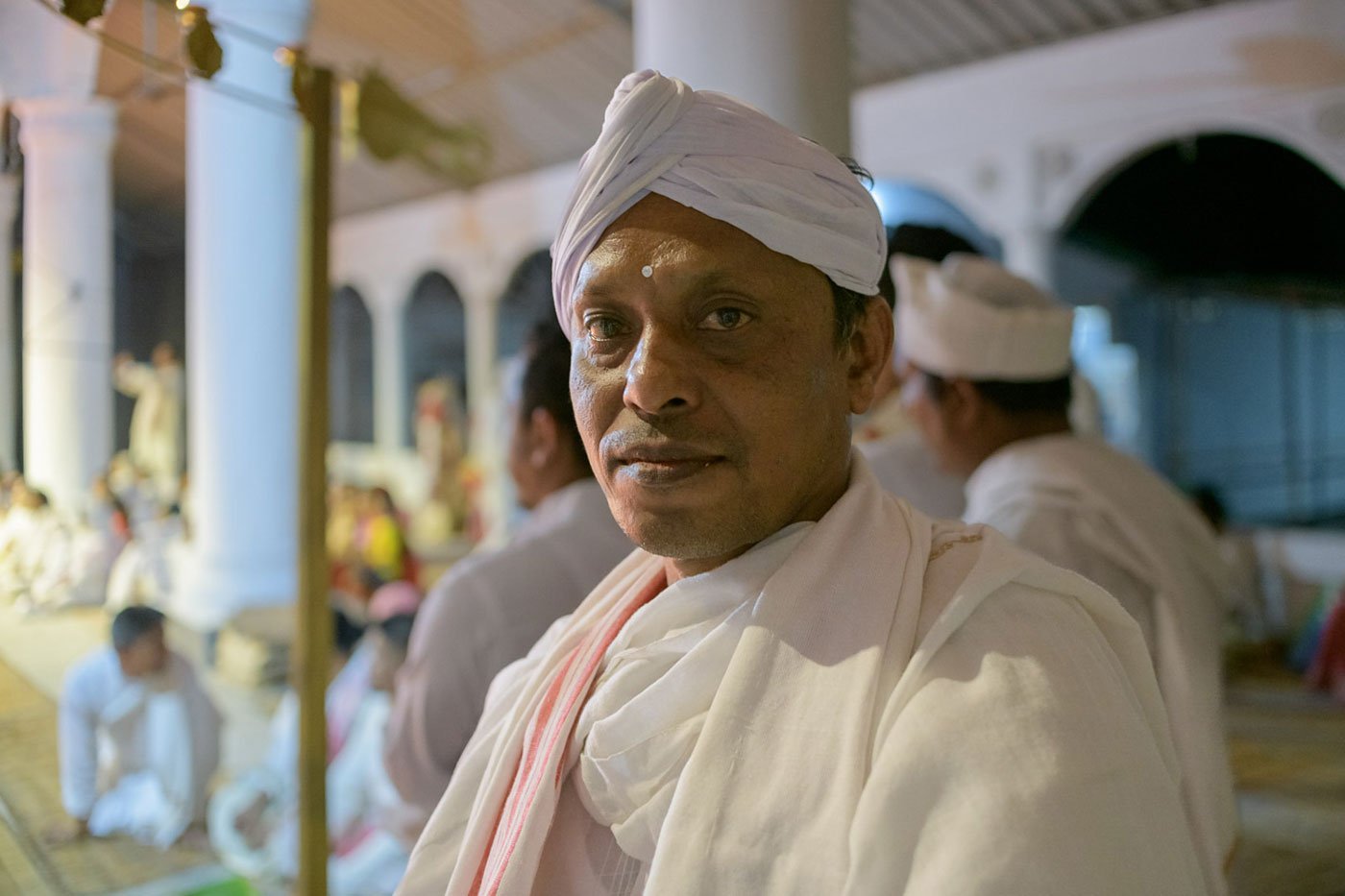
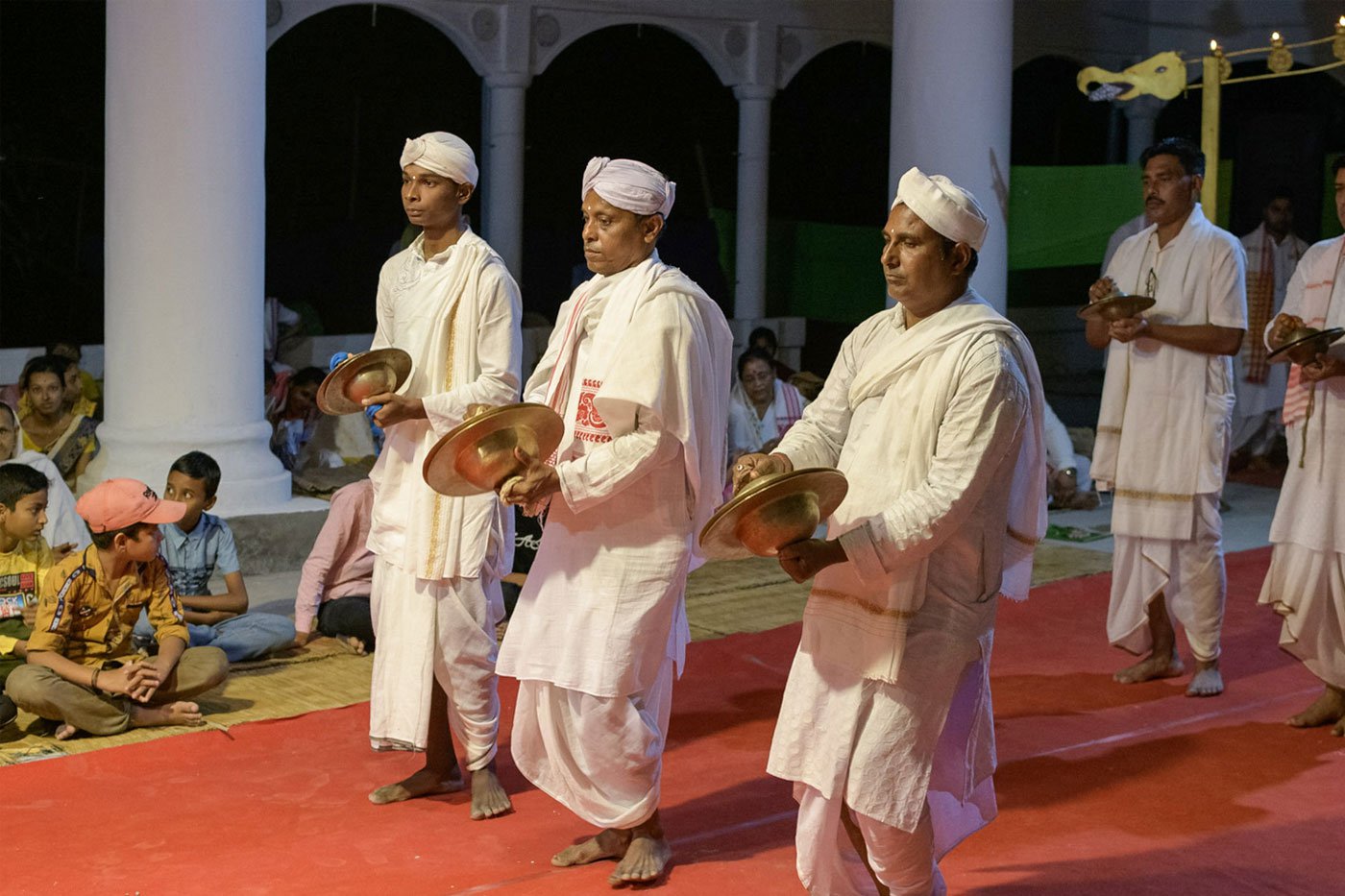
Dutta
started learning
gayan-bayan
at the age of 13. Here, he performs as a
gayan
(singer) with the rest of the group in the
namghar
of the Garamur Saru Satra
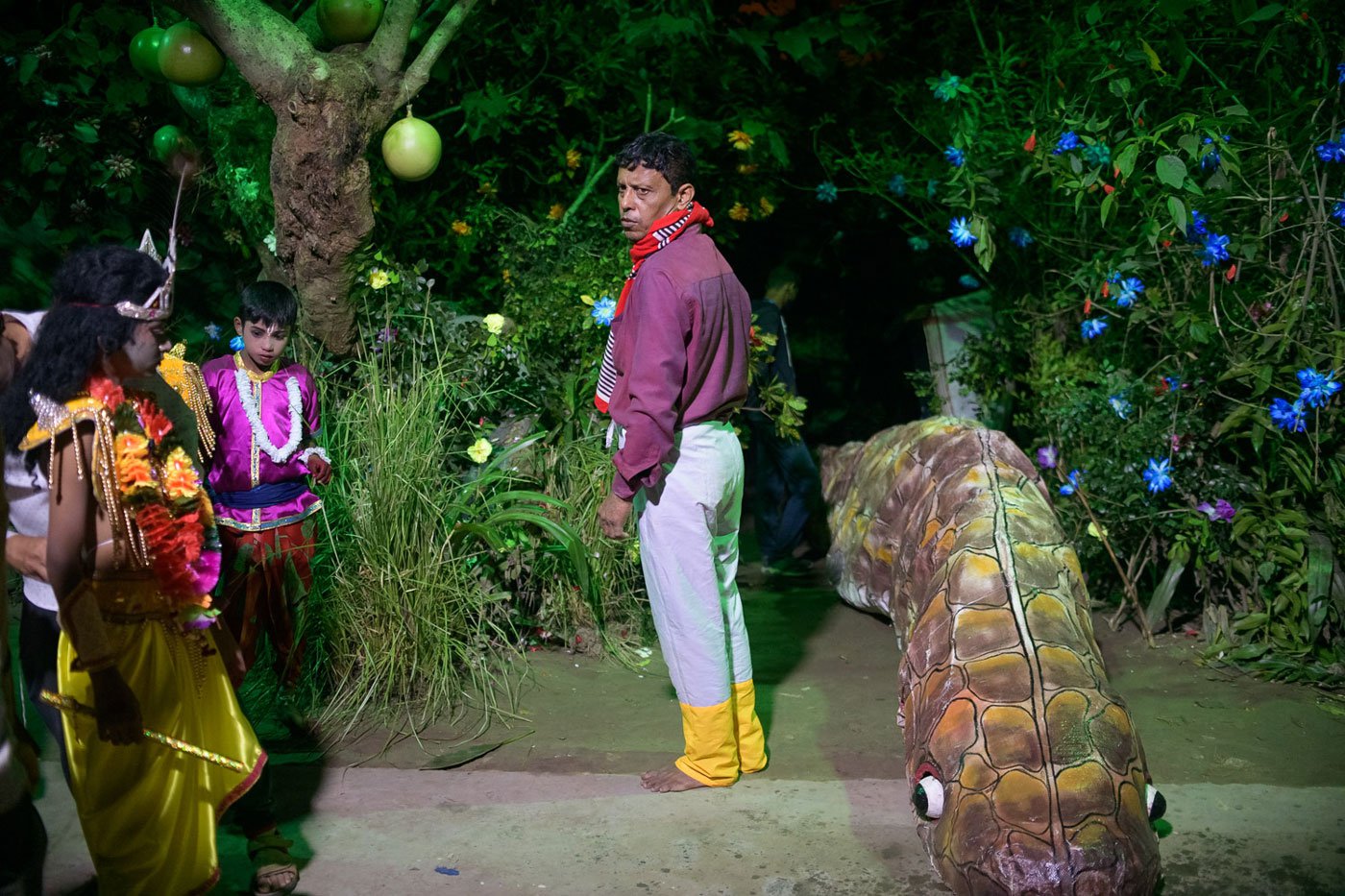
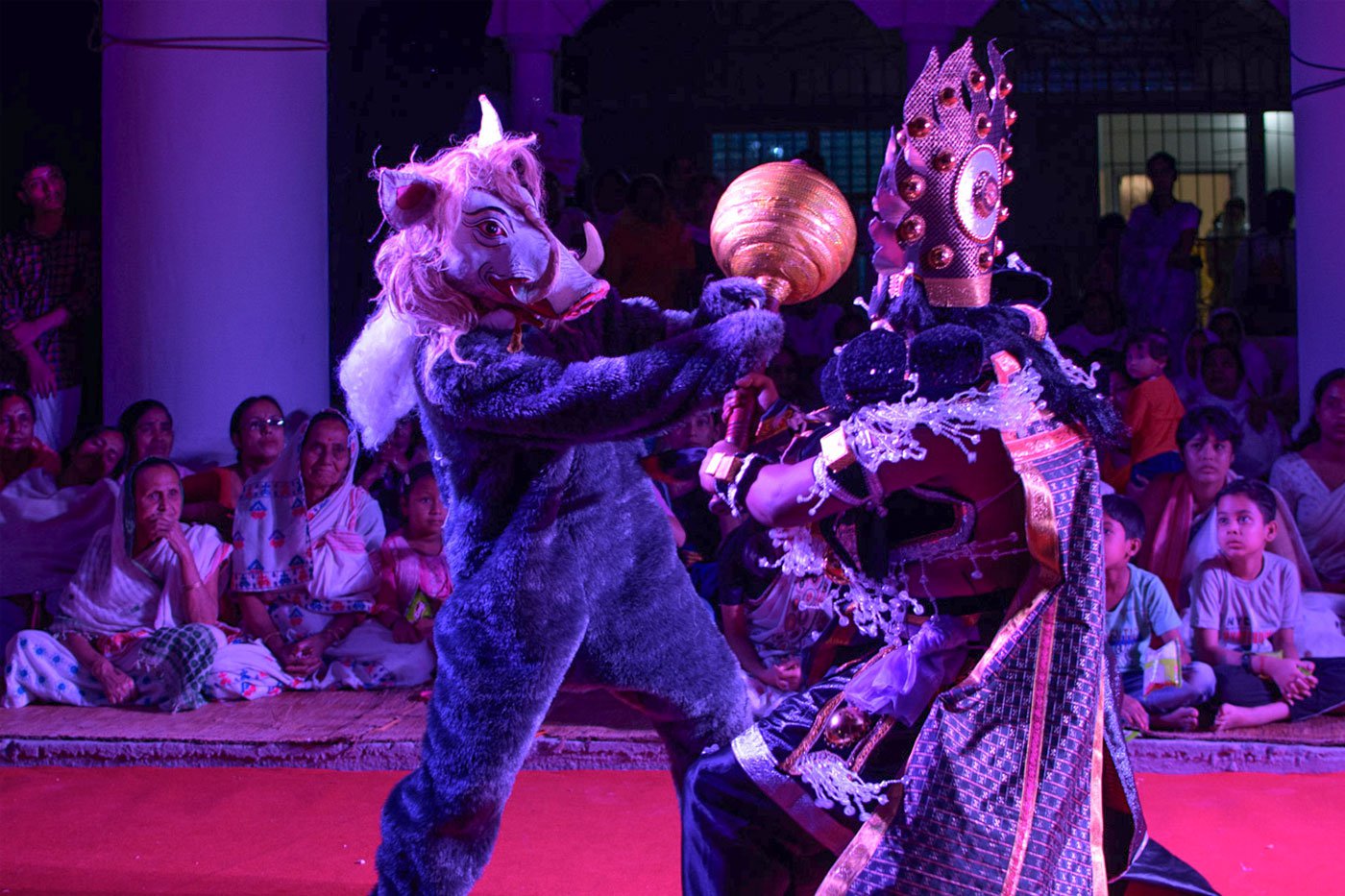
Left: Backstage at the Garamur Saru Satra, Dutta prepares to perform the role of Aghasura, a serpent demon. Right: In the role of Boraho (left), he fights the asura (demon) Hiranyaksha in a drama titled Nri Simha Jatra
*****
The room in which we sit is dimly lit. The walls are plastered over with sand and cement, painted green. Behind Ramesh da hangs a landscape. Anushka, his six-year-old daughter, tells us that all the paintings displayed on the walls were made by her father.
A portion of the cowshed at home makes up his studio. We watch him work on a pair of commissioned sculptures all afternoon – Joy-Bijoy figures for the gates of a namghar [prayer house]. Ramesh da has been making sculptures like these for 20 years. He says it takes him around 20 days to make one.
“First, I build the frame using wood. Then a sand and cement mixture is poured into the frame and left to dry,” he explains as he shapes the torsos of the Joy-Bijoy figures with a karani [trowel]. “After a few days, I begin shaping the sculptures. The delicate detailing comes last.”
Certain parts of the figures, like the limbs, are given shape using casts made with pieces of banana tree trunks. “I buy the materials to make the murti [sculpture] from local stores,” continues Ramesh da . “We mostly use plastic paints these days. Earlier we would use distemper paints, but they fade.”
He steps away from the figures, judging their proportions. Then, making another batch of the concrete mixture he returns to work. “When he is working, he doesn’t talk. Doesn’t like to be disturbed at all,” his wife Neeta, who helps him with his work, tells us with a smile. “When he is engrossed in his work, he has a mood.”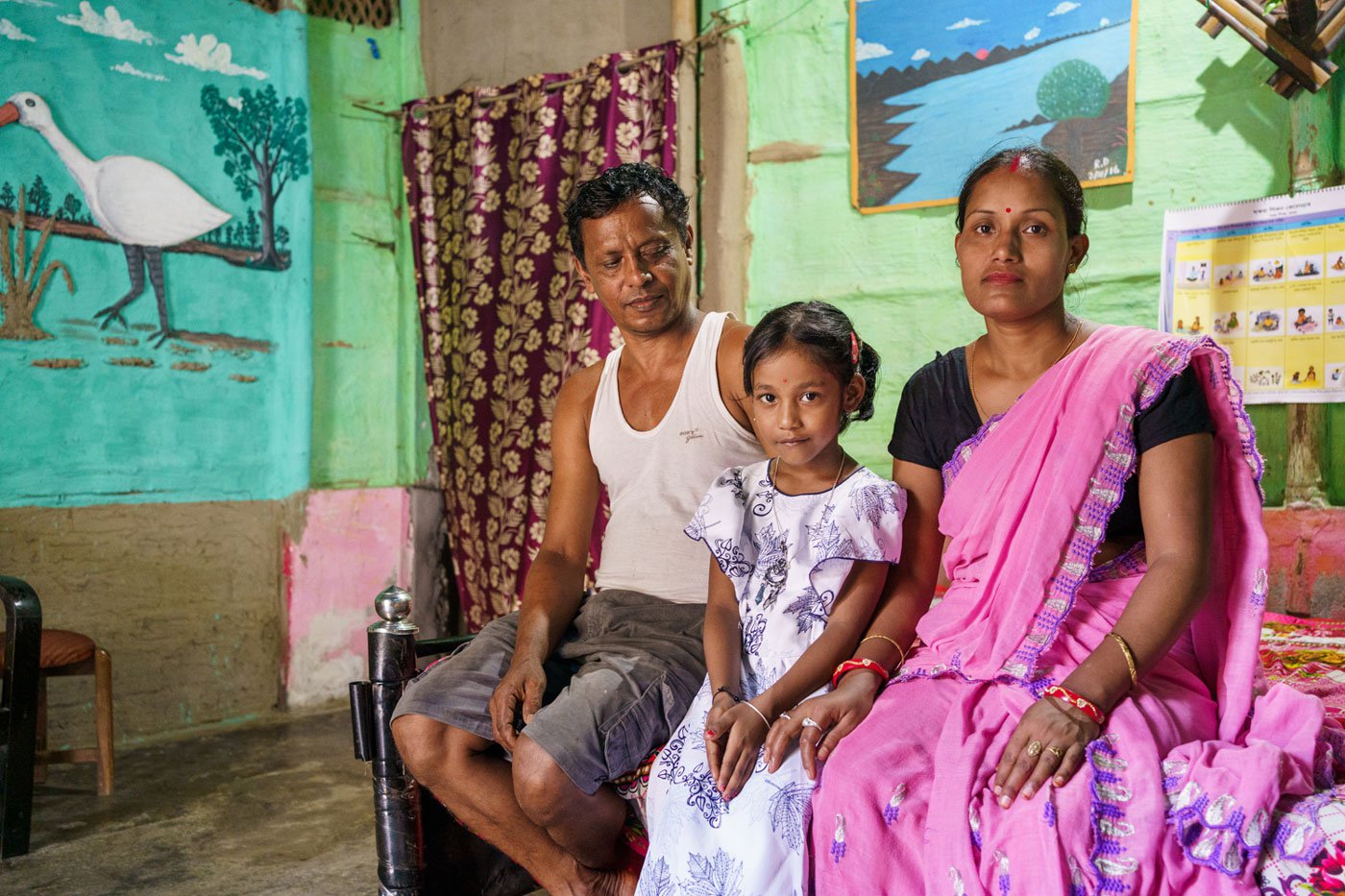
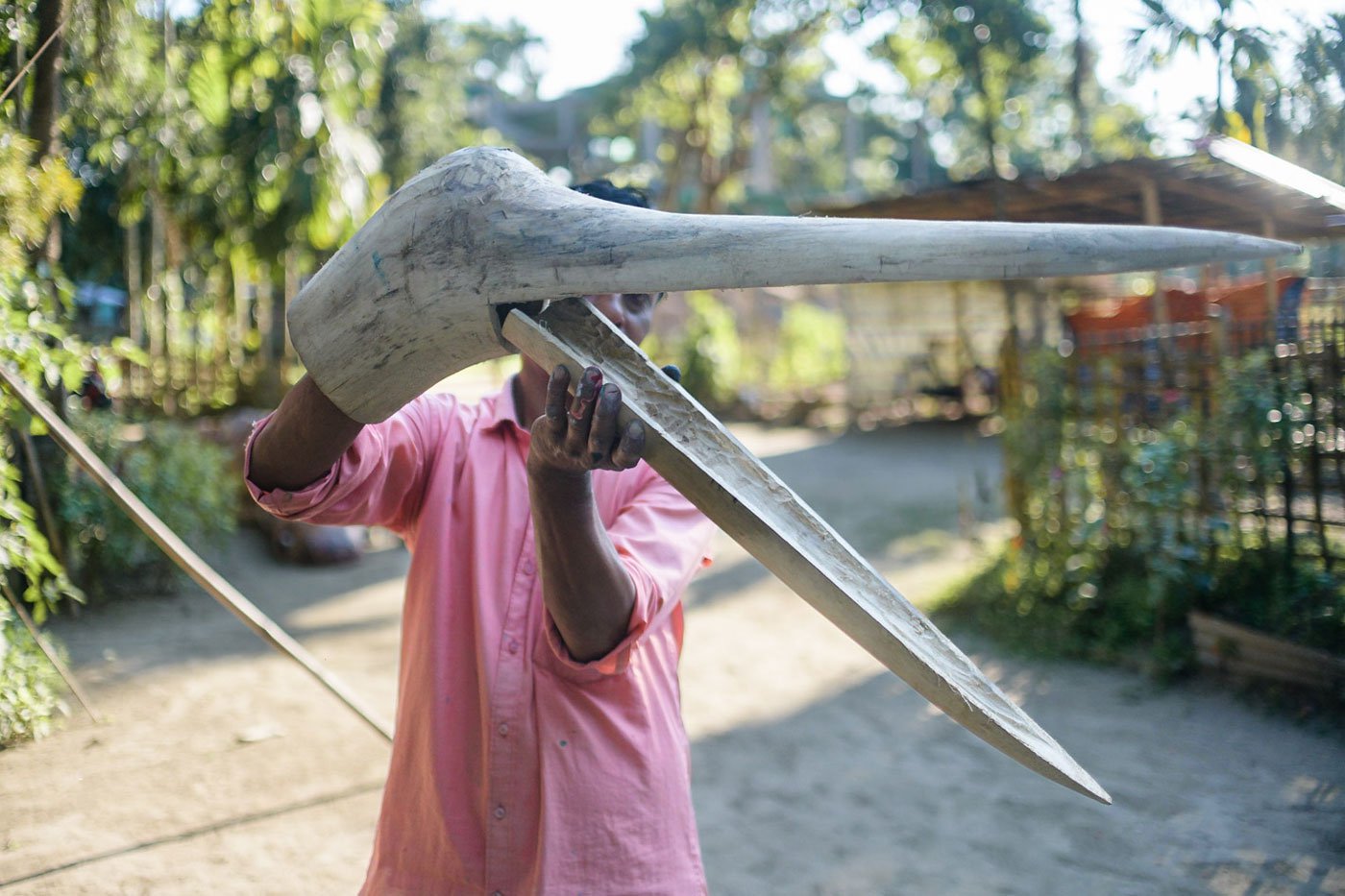
Left: Dutta with his wife Neeta and their daughter Anushka at home in Garamur, Majuli. Right: He demonstrates how he designed a movable beak for a crane mask
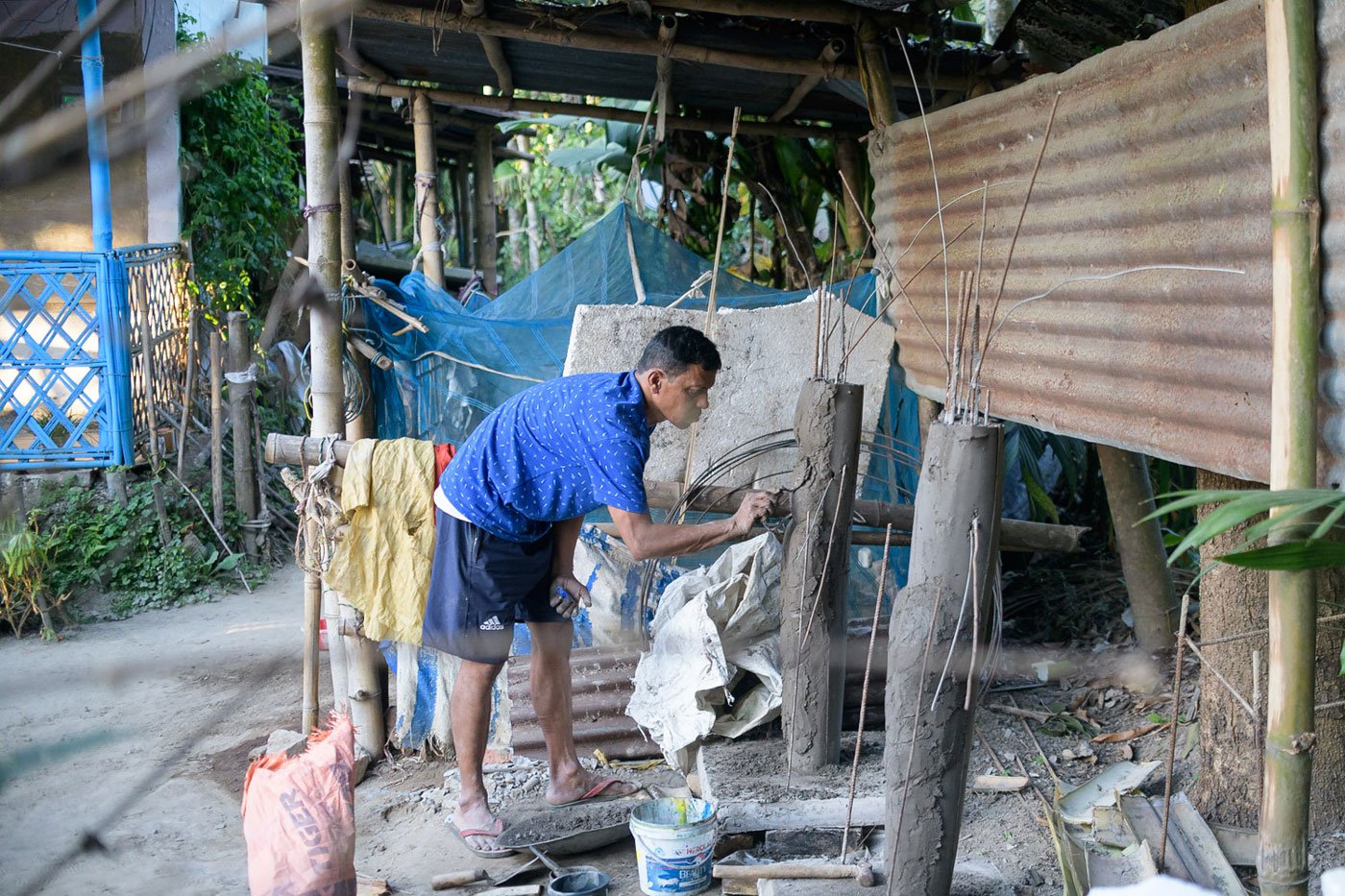
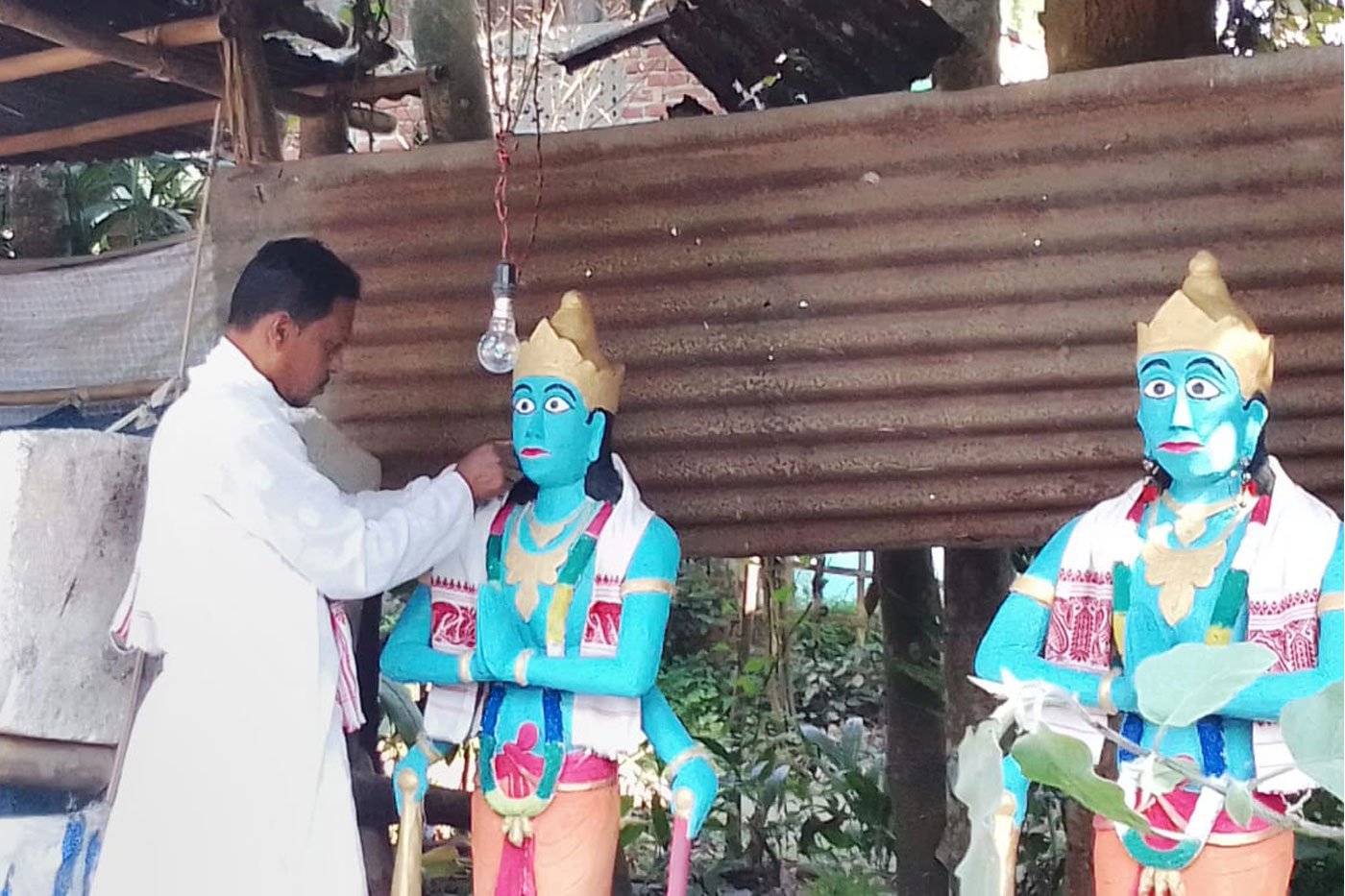
The artist works on a pair of sculptures outside his home. The Joy-Bijoy figures are said to be guards to
namghars
. He makes such sculptures using wooden frames and concrete, and later paints them using fade-proof plastic paints
Dutta is especially proud of the guru axon [guru’s seat] he built for the namghar in the Kharjanpar area near Garamur. The axon is a tetrahedral structure placed within the inner sanctum of the prayer house. “I made the guru axon with concrete and painted it to look like wood. The Satradhikar [head of the satra ] consecrated and inaugurated the axon . Even he mistook it to be made of wood,” he says happily.
He is also busy building a house for his family. “It’s the rainy season so it is taking longer to finish,” says Neeta.
Dutta is the eldest of four siblings and the only one in the family to have taken up art as a profession – ever since Class 8. “This is my profession. I don’t have agricultural land,” he says. “When there is no work, we have to depend on our savings. Life goes on. Sometimes people invite me to do Bhaona [traditional drama]. They need help and I go.
“Some pay 1,000 rupees and others pay 1,500. Some also offer 300. What can you say? It is rajahua kaam [community service]. I quote my rate but people pay as per their capacity.”
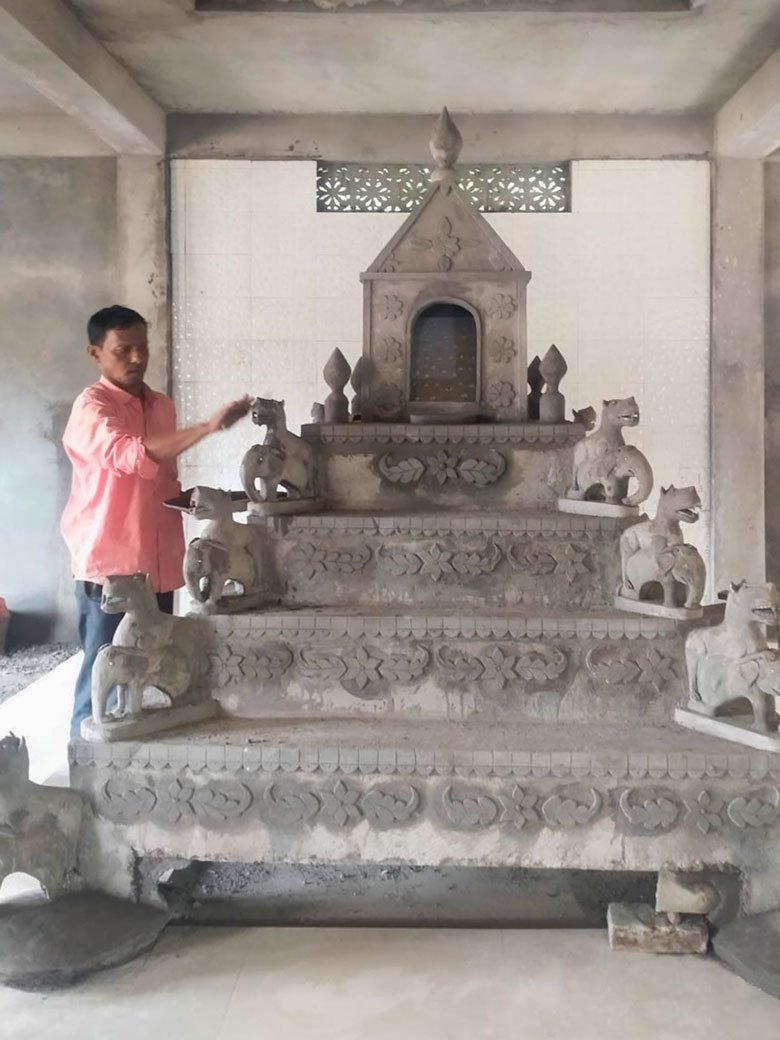
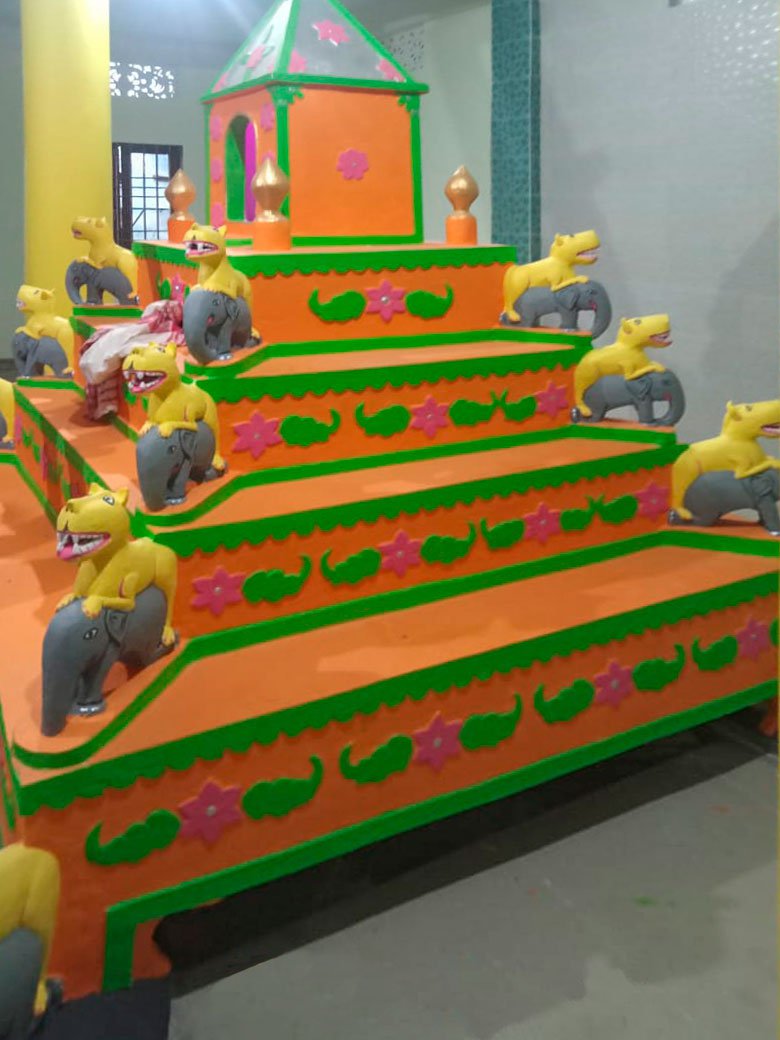
The guru axon (guru's seat) built by Dutta for a namghar in Kharjanpar, Majuli. The axons are usually made of wood but he used concrete and later painted it to resemble wood
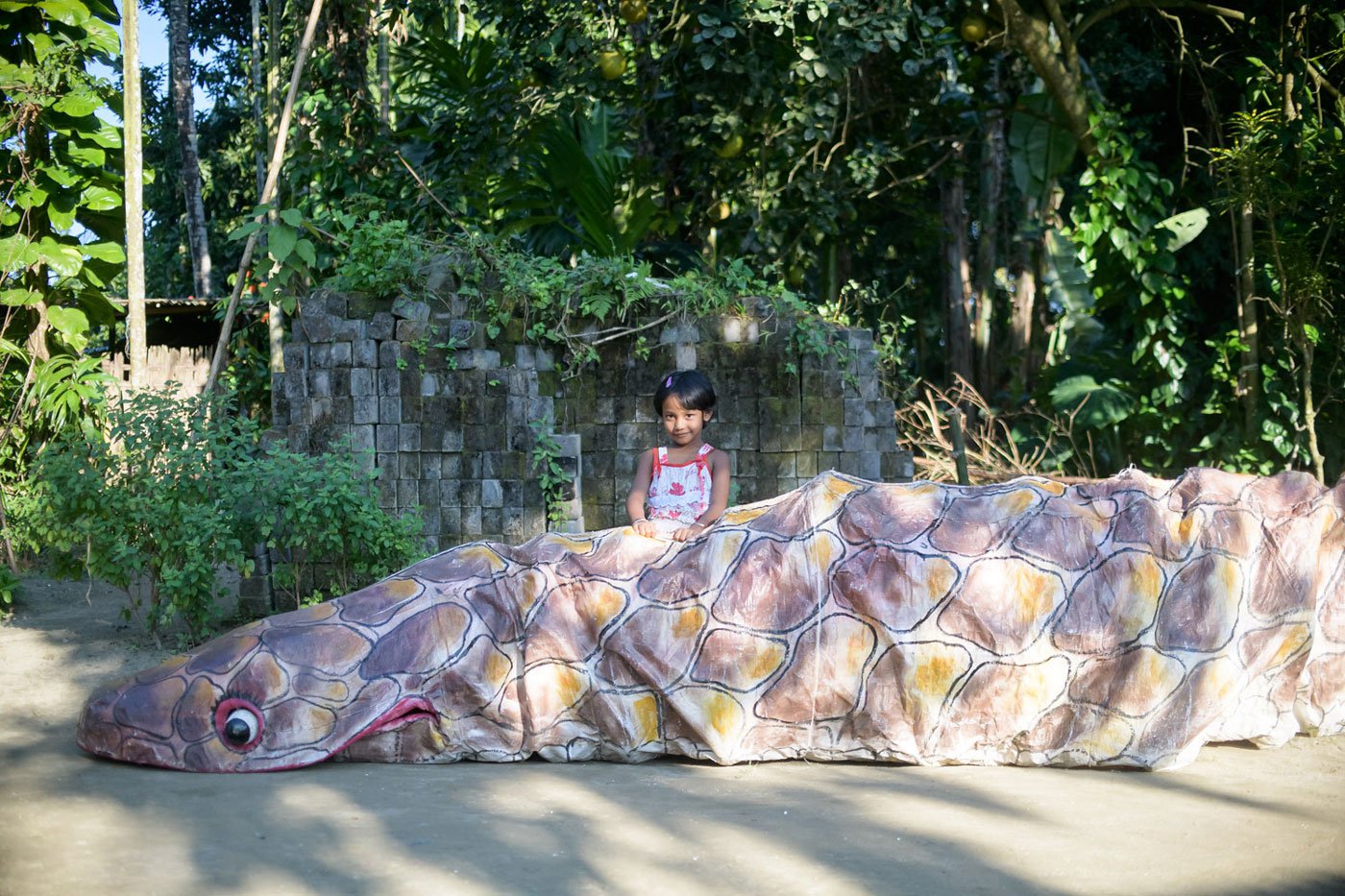
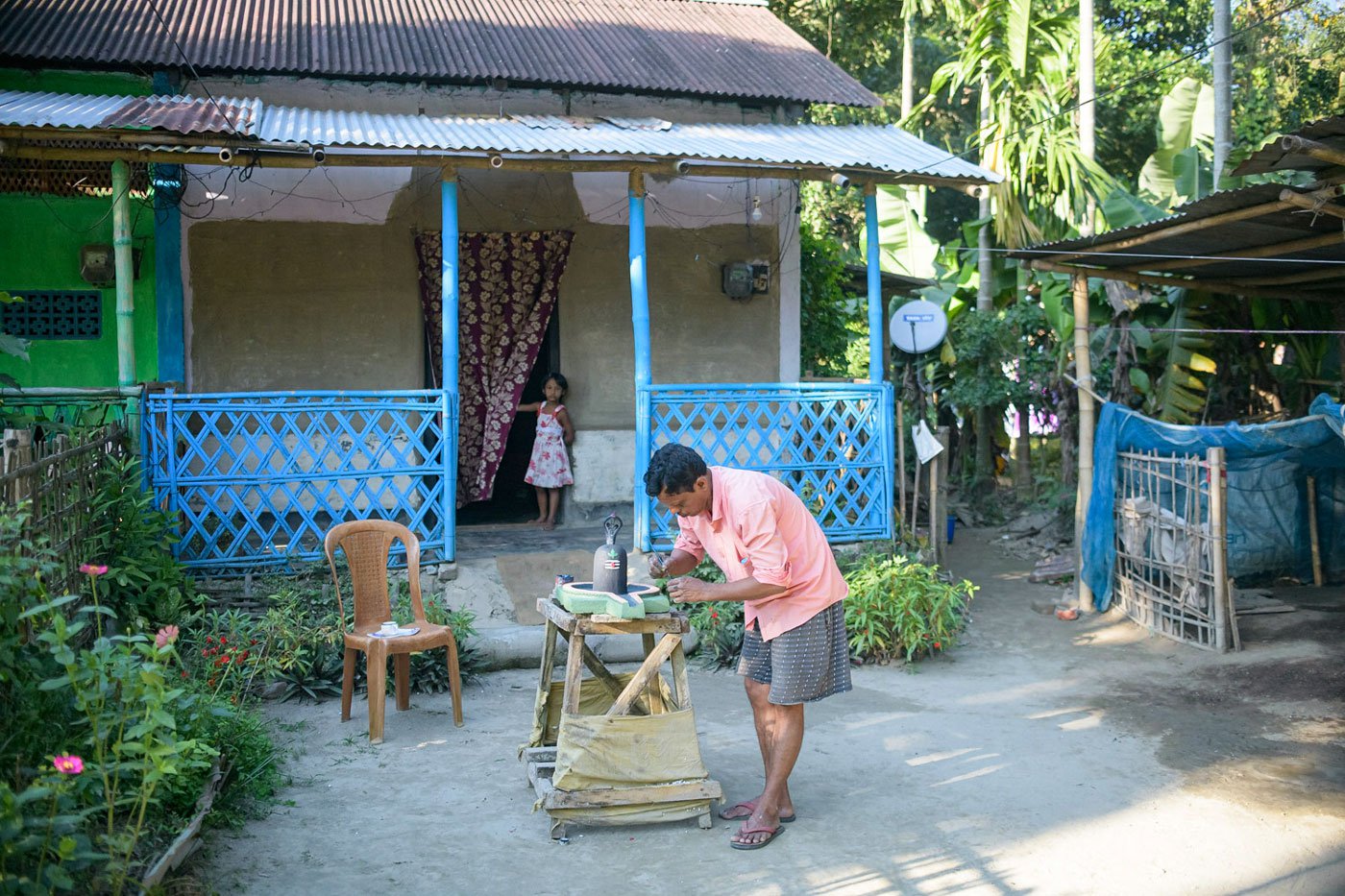
Anushka Dutta stands next to the giant Aghasura costume made by her father for the Raas Mahotsav. The six-year-old looks on as her father works on a project outside their home
While he is understanding of such limitations he also adds, “without artha [money] nothing can be done. It takes money to even start working on something. And at times getting that money becomes difficult.”
One way he navigates such problems is by renting out his work like a mask of the fish incarnation of Vishnu – Motsyo – he made in 2014. “At the time it cost me 400 rupees to buy the materials and sometimes the 400 also becomes difficult to manage.” In the six years since then, he has made around Rs. 50,000 by renting it out.
Dutta has no fixed rate for the kind of work he does. Even if a sculpture is small, the khatoni [physical effort] required is a lot. “Sometimes, the hazira [wages earned for work] is inadequate,” he says.
“It is like a game of cards. One has to find hope in hopelessness.”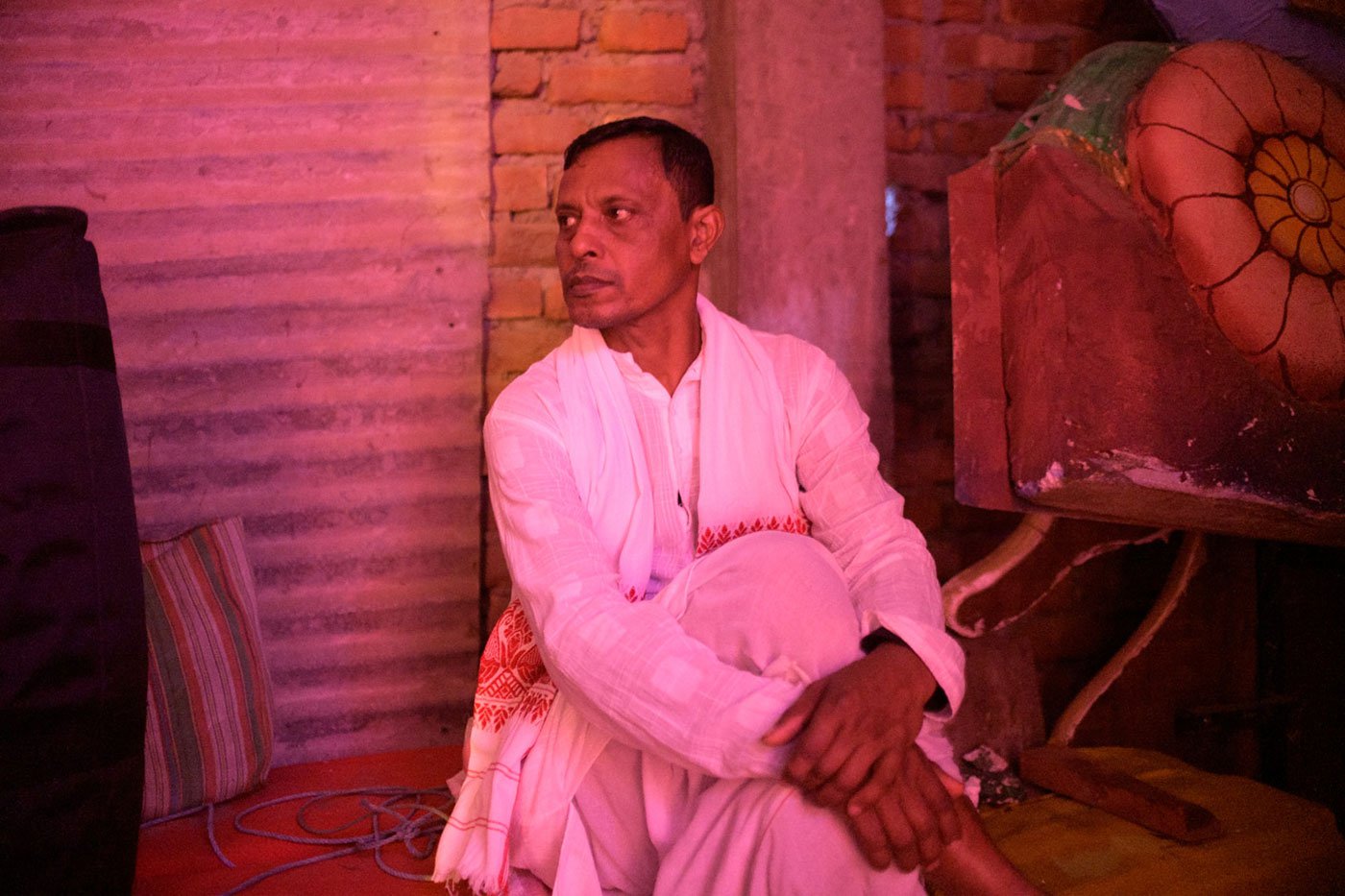
Backstage at the Garamur Saru Satra auditorium, Dutta waits for his Gayan-Bayan performance to begin
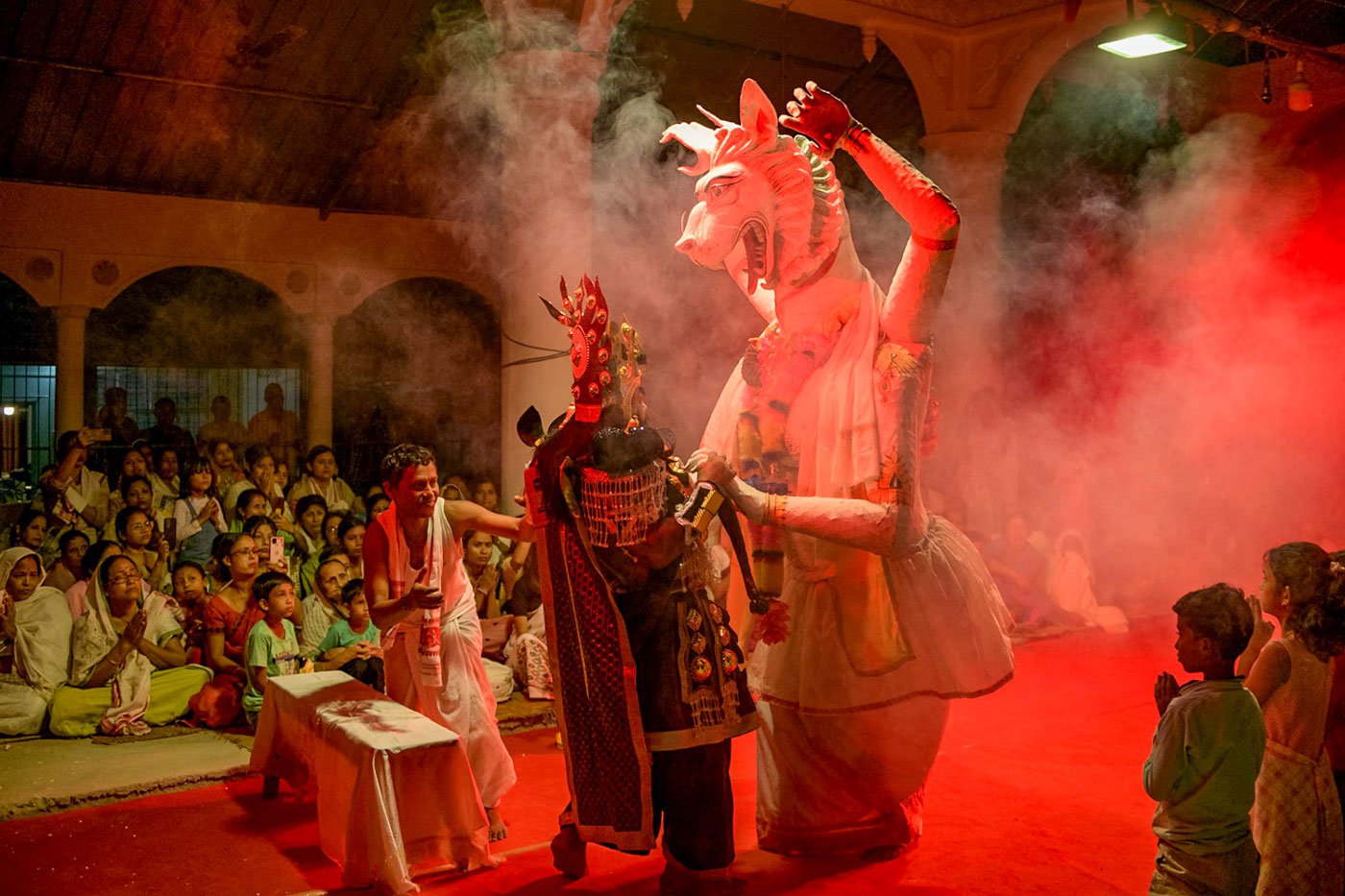
In a scene from the Nri Simha Jatra drama, Dutta (left) helps the actor wearing the mask of the half lion, half human Nri Simha
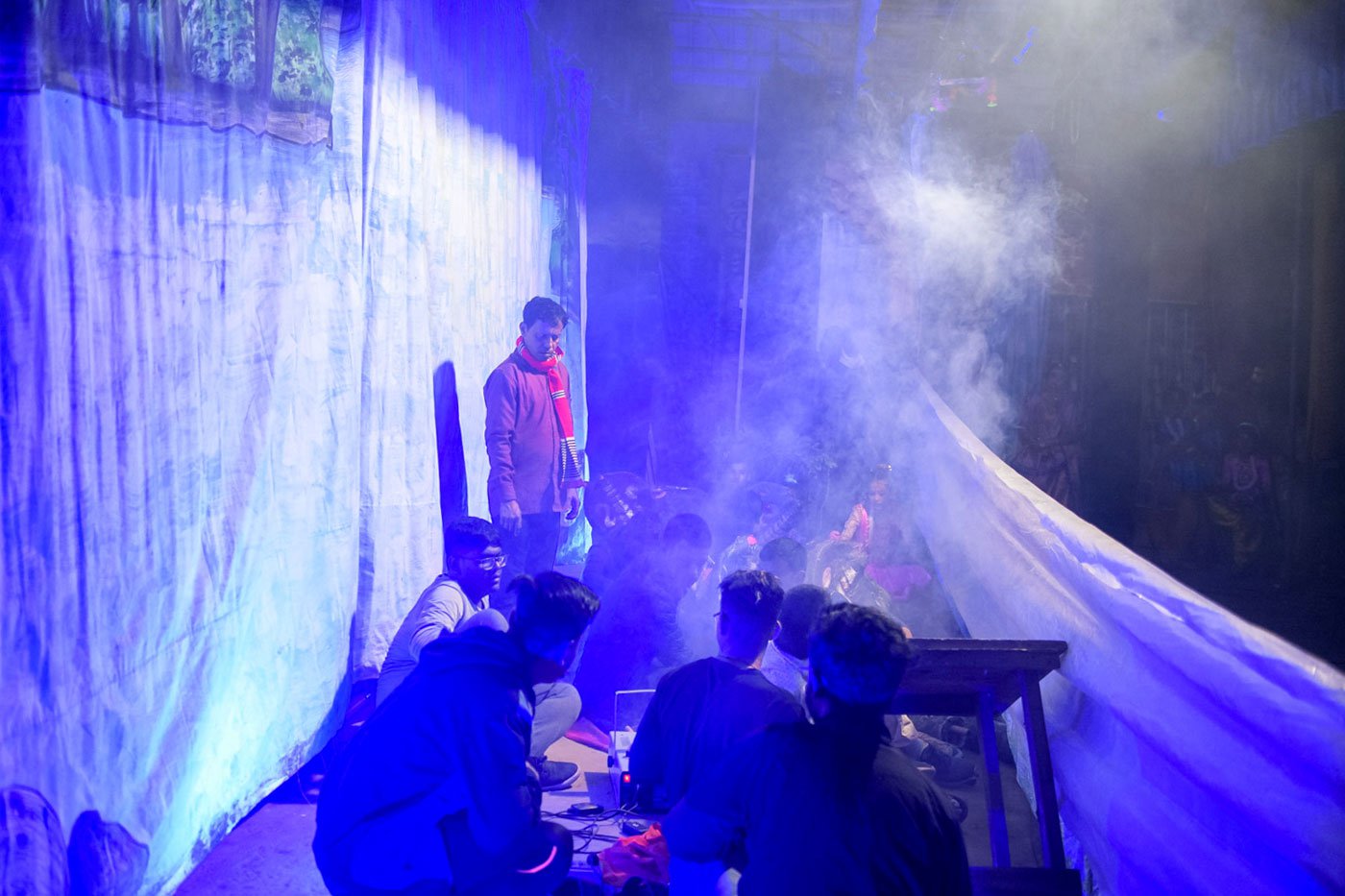
The artist prepares the set for the Kaliyo daman scene of the Raas performance wherein Lord Krishna defeats the Kaliyo Naag living in the Yamuna river
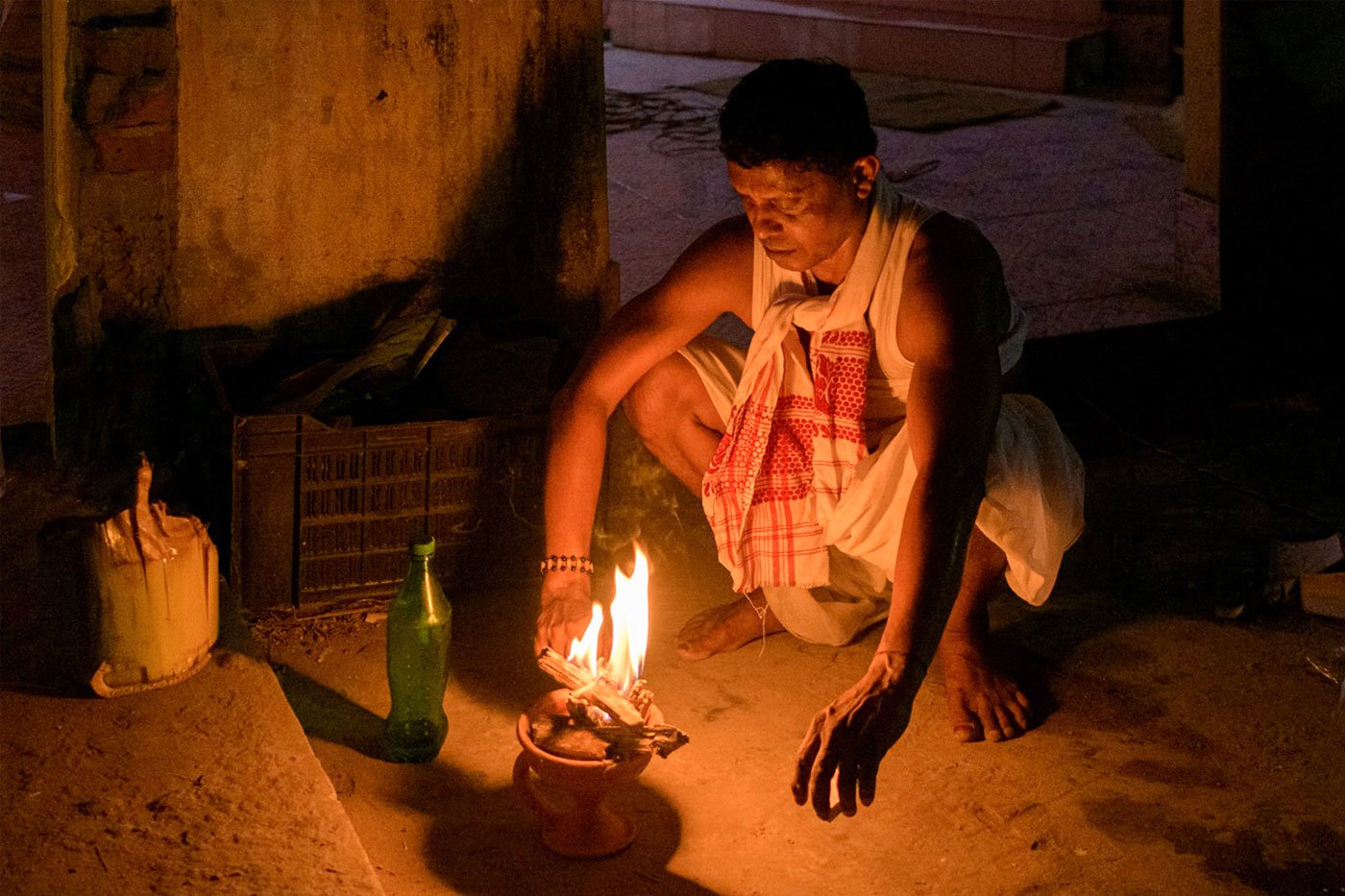
Dutta, after his performance as Boraho, lights a dhuna for prayer
This story is supported by a fellowship from Mrinalini Mukherjee Foundation (MMF).
